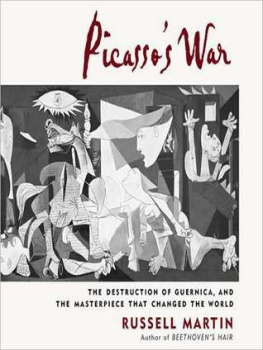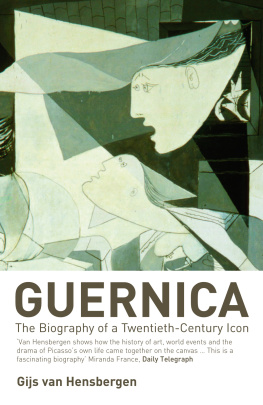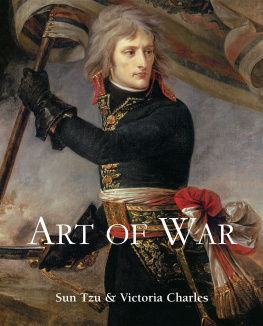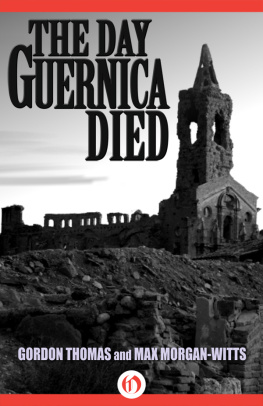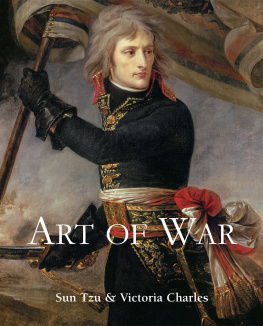Russell Martin - Picassos War: The Destruction of Guernica, and the Masterpiece That Changed the World
Here you can read online Russell Martin - Picassos War: The Destruction of Guernica, and the Masterpiece That Changed the World full text of the book (entire story) in english for free. Download pdf and epub, get meaning, cover and reviews about this ebook. publisher: HighBridge Company, genre: Art. Description of the work, (preface) as well as reviews are available. Best literature library LitArk.com created for fans of good reading and offers a wide selection of genres:
Romance novel
Science fiction
Adventure
Detective
Science
History
Home and family
Prose
Art
Politics
Computer
Non-fiction
Religion
Business
Children
Humor
Choose a favorite category and find really read worthwhile books. Enjoy immersion in the world of imagination, feel the emotions of the characters or learn something new for yourself, make an fascinating discovery.
- Book:Picassos War: The Destruction of Guernica, and the Masterpiece That Changed the World
- Author:
- Publisher:HighBridge Company
- Genre:
- Rating:5 / 5
- Favourites:Add to favourites
- Your mark:
- 100
- 1
- 2
- 3
- 4
- 5
Picassos War: The Destruction of Guernica, and the Masterpiece That Changed the World: summary, description and annotation
We offer to read an annotation, description, summary or preface (depends on what the author of the book "Picassos War: The Destruction of Guernica, and the Masterpiece That Changed the World" wrote himself). If you haven't found the necessary information about the book — write in the comments, we will try to find it.
Russell Martin: author's other books
Who wrote Picassos War: The Destruction of Guernica, and the Masterpiece That Changed the World? Find out the surname, the name of the author of the book and a list of all author's works by series.
Picassos War: The Destruction of Guernica, and the Masterpiece That Changed the World — read online for free the complete book (whole text) full work
Below is the text of the book, divided by pages. System saving the place of the last page read, allows you to conveniently read the book "Picassos War: The Destruction of Guernica, and the Masterpiece That Changed the World" online for free, without having to search again every time where you left off. Put a bookmark, and you can go to the page where you finished reading at any time.
Font size:
Interval:
Bookmark:
Contents

Paul Preston is the worlds foremost historian of twentieth-century Spain and the author of many books including the standard biographies of General Franco and King Juan Carlos and The Spanish Civil War, hailed as a definitive work [The Times]. He is an Emeritus Professor at the London School of Economics, a Fellow of the British Academy and lives in London.
The military rebellion that provoked the Spanish Civil War began on the evening of 17 July in Spains two North African enclaves of Ceuta and Melilla and in the peninsula on the following morning. In every province, a rebel commander launched the coup by a declaration of martial law. Success or otherwise broadly followed the electoral geography of the country. In rural areas of right-wing Catholic small-holders, the coup was successful and in areas of left-wing dominance, working class resistance was massive. On 19 July 1936, shortly after his declaration of martial law in Pamplona, the general who had organised the coup, Emilio Mola called a meeting of the mayors of the province of Navarre. He spoke in his capacity as commander of the northern rebel forces. What he told the mayors would characterise the rebels war effort in general and particularly his own subsequent treatment of the Basque Country. He said: It is necessary to spread terror. We have to create the impression of mastery, eliminating without scruples or hesitation all those who do not think as we do. There can be no cowardice. If we vacillate one moment and fail to proceed with the greatest determination, we will not win. Anyone who helps or hides a communist or a supporter of the Popular Front will be shot.
Because of early reverses he had suffered in the sierra north of Madrid, Molas first major campaign against the Basque Country did not begin until after the military rebels received substantial German and Italian aid in early August. This enabled him to launch an attack on the eastern Basque province of Guipzcoa, which bordered France. It also enabled the commander of the rebel forces in southern Spain, General Francisco Franco, to begin his march on Madrid. Already, on 23 July, units of the deeply reactionary Carlist militia from Navarre had entered the southern part of Guipzcoa through Cegama and Segura. Although they encountered no resistance, in both towns, they sacked the headquarters of Republican parties and the Batzoki (headquarters) of the Basque Nationalist Party (Partido Nacionalista Vasco). Now, in early August, Mola began a campaign to capture Irn and San Sebastin and cut off Guipzcoa from the French border. Irn and Fuenterraba were being shelled from the sea and attacked daily by German and Italian bombers. The South African-born British correspondent George Steer noted that the rebels had dropped pamphlets threatening to deal with the population as they had dealt with those in Badajoz, where the notorious massacre in the bull-ring had taken well over 2,000 lives. The tactic of evoking earlier atrocities as a warning of what would happen if surrender were not immediate would be used again eight months later when the experience of Guernica would be used as a threat against Bilbao, the principal Basque city and the regions industrial dynamo. San Sebastin was also heavily shelled from the sea. Irns poorly armed and untrained militia defenders fought bravely but were overwhelmed on 3 September. Thousands of panic-stricken refugees fled across the international bridge to France. The last defenders, largely anarchists enraged by their lack of ammunition, shot some rightist prisoners in Fuenterraba and set parts of Irn on fire.
Rebel troops and Carlists occupied San Sebastin on Sunday 13 September and by the end of the month virtually all of Guipzcoa was in Molas hands.
Even before the fall of San Sebastin, Mola had initiated secret negotiations with the Partido Nacionalista Vasco. He hoped for a peaceful surrender of Vizcaya in return for a promise not to destroy Bilbao and a guarantee of no subsequent repression. In the light of what had happened after the captures of Irn and San Sebastin, the PNV leadership had no reason to believe Molas promises. Over the course of the negotiations, appeals were made to him not to bomb Bilbao on the grounds that to do so would provoke reprisals against the 2,500 imprisoned rightists in the city. On 25 and 26 September, major bombing raids on Bilbao caused dozens of deaths and mutilations of women and children, which, as predicted, provoked an outburst of rage from the starving population.
Rebel hostility to the Basque Country intensified after the concession of regional autonomy by Madrid on 1 October and the formation of a Basque government six days later. The newly elected President of the Basque government, Jos Antonio de Aguirre y Lecube, and his cabinet were sworn in at a ceremony before the Tree of Guernica. In his speech Aguirre declared, The tradition of our elders was once again reborn in us, and the sacred Tree that in Guernica grows was no longer a relic, but became once again the living symbol of our history.
Sporadic bombing raids continued on Bilbao but nothing had prepared the city for the scale of another attack on 4 January 1937. In an even more ferocious incursion into the citys four prisons, 224 rightists were killed including several priests, most of them Carlists but some Basque Nationalists.
Franco initially remained obsessed with Madrid. General Hugo Sperrle, the commander of the crack Condor Legion, sent by Hitler to aid Franco, put forward similar arguments with even greater insistence. News of the defeat at Guadalajara on 20 March 1937 changed Francos thinking, made him to succumb to the pressure from Sperrle and Vign and accept that the defeat of the Republic must be sought somewhere other than the outskirts of Madrid. Sperrle persuaded him that resistance in the north would be slight, with promises about the likely impact of concerted airborne ground attacks by the Condor Legion. On 22 March, the Generalsimo presented General Alfredo Kindeln, the head of the rebel air force, with a sketchy outline of his immediate plans for a huge new force to be massed to attack and take Bilbao. On 23 March, he summoned Mola to Salamanca and gave him specific orders for the assault on Bilbao which derived from Vigns suggestions and Sperrles proposals.
The operational details were hammered out at meetings held on 24 and 26 March involving Kindeln, General Jos Solchaga and General Jos Lpez Pinto as field commanders, Vign as Molas chief of staff and Lieutenant Colonel Wolfram von Richthofen, the Condor Legions chief of staff. Richthofen explained to his Spanish counterparts the novel strategy of close air support, using aircraft for sustained ground attack to smash the morale of opposing troops. Accordingly, arrangements were made at these meetings for continuous and rapid liaison between the headquarters of the Spanish ground forces and the Condor Legion. Two hours before any attack, the air force commanders would inform the ground headquarters in order for the necessary coordination to take place. It was also agreed at these meetings that attacks would proceed without taking into account the civilian population.
Mola gathered a large army consisting of African army units, of the Carlist militia known as requets now fully militarised as the Navarrese Brigades and of mixed Spanish-Italian brigades. It was backed by the air support of the small but well-equipped Condor Legion and of units of the Italian Aviazione Legionaria under Richthofens command.
In practice, however, the need to integrate joint air/ground operations on an hour-by-hour basis rendered liaison with Francos headquarters in Salamanca impracticable. So, content with Sperrles deferential manner, Franco allowed him a free hand to liaise directly with Mola and Vign, except on major issues. Franco was delighted to be able to consider the crack Condor Legion as part of his forces and to sit back and take the credit for its achievements. In the field, Mola and Vign were also happy to accept the help and advice of Sperrle and Richthofen, and the consequence was that, with Francos conscious acquiescence, the Germans had the decisive voice in the campaign. Sperrle wrote in 1939, All suggestions made by the Condor Legion for the conduct of the war were accepted gratefully and followed. While the advance was being planned, Richthofen wrote in his diary on 24 March 1937, we are practically in charge of the entire business without any of the responsibility and, on 28 March, I am an omnipotent and effective commander (Feldherr) and I have established effective ground/air command.
Next pageFont size:
Interval:
Bookmark:
Similar books «Picassos War: The Destruction of Guernica, and the Masterpiece That Changed the World»
Look at similar books to Picassos War: The Destruction of Guernica, and the Masterpiece That Changed the World. We have selected literature similar in name and meaning in the hope of providing readers with more options to find new, interesting, not yet read works.
Discussion, reviews of the book Picassos War: The Destruction of Guernica, and the Masterpiece That Changed the World and just readers' own opinions. Leave your comments, write what you think about the work, its meaning or the main characters. Specify what exactly you liked and what you didn't like, and why you think so.

